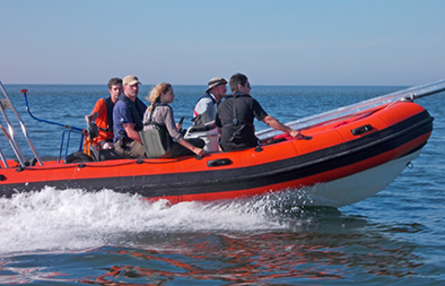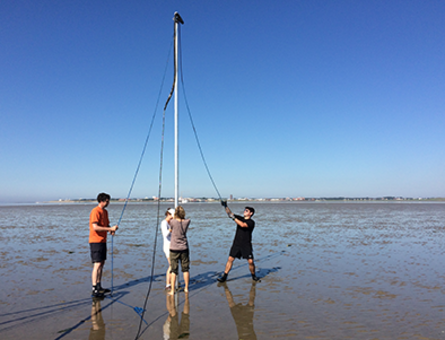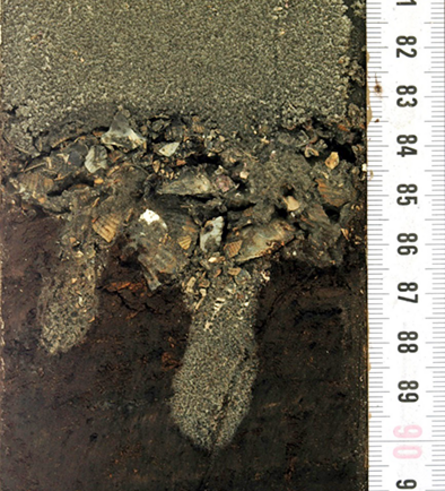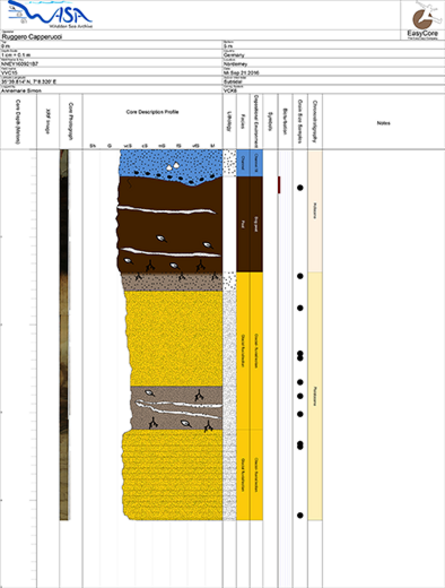
The Wadden Sea archive of landscape evolution, climate change and settlement history: exploration – analysis – predictive modelling (WASA)
The Wadden Sea Archive project (WASA) is headed and coordinated by the Lower Saxony Institute for Historical Coastal Research. Project partners include the Institute “Senckenberg by the Sea” (SaM), the Coastal Research Facility of the Lower Saxony Agency for Water Management, Coastal- and Environmental Protection (NLWKN-FSK) and Bremen University (Institute of Geography).
The interdisciplinary project combines into a multi-proxy approach the know-how of working groups from the fields of sedimentology, geophysics, geochemistry, palaeobiology, archaeology and offshore engineering. Project WASA focusses on the analysis of marine sediment archives and is aimed at understanding palaeolandscapes since the end of the last ice age. This provides the basis for the location of potential archaeological settlement areas.
The present-day area of the North Sea coast experienced several stages of coastal evolution as a consequence of the temperature rise at the end of the last ice age and the resultant sea level rise. Peat lying immediately above the Pleistocene sands or intercalated within the sequence of coastal sediments are relicts of wide landscapes of coastal fens. They are alternating with sediments of calmer tracts of coastline and more dynamic mud deposits as well as channel sediments. These alternations within the sedimentation sequence are reflective of repeated coastline shifts both landwards as well as seawards, which can amount to several kilometres. As a consequence the habitation area for man and beast was covered by sediments within which the traces of “drowned” life can be preserved for millennia. Numerous archaeological finds attest to these areas being occupied by humans in prehistoric times. The Lower Saxony Wadden Sea is thus a unique archive of environmental- and cultural history. This is the starting point for Project WASA because it is this archive which allows studying the postglacial landscape - and vegetation history, sedimentation processes along with sea level development and climatic variations by employing a wide array of methodologies including earth- and life sciences as well archaeology.
A total of 120 drillings to a depth of up to 6 m are planned within the scope of the project in the mudflats off the shores of the East Frisian Islands of Norderney and Langeoog. Hydroacoustic soundings of the area will be carried at the same time in order to gather further, area-wide information about the underground. Following the assessment of the results, the retrieved data will be summarised into geographic information systems and spatially analysed with the aim of reconstructing palaeolandscapes and identifying potential archaeological settlement areas.
Funding:
The project received financial support totalling €1.8 million from funds of the “Niedersachsen Vorab”-scheme by the Lower Saxony Ministry for Science and Culture as well as the Volkswagen Foundation.
The project started in May 2016 and will continue until December 2020.
Bibliography
Bartholomä, A, Capperucci, R., Bungenstock, F., Schaumann, R., Toebrock, L., Enters, D., Wehrmann, A. & Drews, E., 2020: Rekonstruktion versunkener Landschaften im ostfriesischen Wattenmeer – Ergebnisse aus den geophysikalischen Messungen und Kernbohrungen im Projekt WASA. Nachrichten des Marschenrates 57: 61-69.
Scheder, J., Frenzel, P., Bungenstock, F., Engel, M., Brückner, H. & Pint, A., (2019): Vertical and lateral distribution of Foraminifera and Ostracoda in the East Frisian Wadden Sea – developing a transfer function for relative sea-level change. Geologica Belgica 22/3-4: 97-108.
Scheder, J, Pint, A., Engel, M, Bungenstock, F., Frenzel, P.& Brückner, H., 2019: Foraminiferen und Ostrakoden im Ostfriesischen Wattenmeer – Ein Beitrag zur Meeresspiegelrekonstruktion. Nachrichten des Marschenrates 56: 39-44.
Bulian, F., Enters, D., Schlütz, F., Scheder, J., Blume, K., Zolitschka, B. & Bittmann, F., 2019: Multi-proxy reconstruction of Holocene paleoenvironments from a sediment core retrieved from the Wadden Sea near Norderney, East Frisia, Germany. Estuarine, Coastal and Shelf Science 225, 106251
Hüser, A., 2018: Der Emsuferwall in Ostfriesland Leben zwischen Fluss und Moor. Archäologie in Niedersachsen 21: 98–101.



